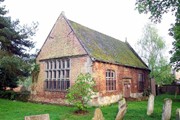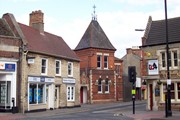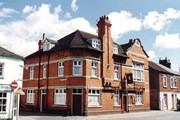 |
 |
 |
PRESERVING OUR HISTORIC BUILDINGS
by Anthony Jennings
 |
 |
 |
PRESERVING OUR HISTORIC BUILDINGS
by Anthony Jennings
|
THE LOCAL CONSERVATION organisation known as Bourne Preservation Society (BPS) is a charitable amenity society that strives to maintain the historic fabric of Bourne and its surrounding villages, and seeks to ensure that the area maintains its local distinctiveness. It works with the town and county authorities, and other organisations, to inform and educate about Bourne's history and its conservation. It has monthly meetings with speakers and discussions. One of the aims of BPS is to enhance and enlarge the designated Bourne Conservation Area, and this has achieved recent success with the extension by South Kesteven District Council (SKDC) of Bourne Conservation Area along sections of West Road and North Road in particular. These areas form the post-Georgian period of Bourne's development and contain some fine Victorian and Edwardian houses in the eclectic styles of the day, including Italianate, Gothic revival and Arts and Crafts. In conjunction with this extension, and with the co-operation of SKDC, the society has launched its Bourne Conservation Area Guidance Leaflet. This free illustrated leaflet has been distributed to every household and business within the Bourne Conservation Area as an enclosure with the letter confirming the extension of the Area. The leaflet, prepared by BPS, gives basic guidance on the conservation of properties within the area. It explains that the purpose of the Conservation Area is to conserve and enhance the historic parts of the town for the benefit of all who live in it and visit it. It summarises the history of Bourne and describes the key characteristics of the Conservation Area and the listed and other notable buildings within it. It emphasises that property within the Conservation Area is subject to stronger legal constraints than property outside it, and that residents should consult South Kesteven District Council if they are in any doubt as to what they are not permitted to do. It points out that these constraints should not be seen as oppressive but beneficial. It explains how everyone can help the efforts of BPS to promote Bourne as an attractive venue, and how the worst obstacles to that goal can be avoided. Each building needs to be considered individually, but the main general problems include:
Original features such as wooden doors, sash windows and leaded lights should not be removed but repaired and maintained. Wholesale renovation does more harm than good by destroying historic character, particularly when carried out with inappropriate, short-lived and environmentally unfriendly materials such as uPVC. It also notes that if it becomes necessary to replace an existing inappropriate feature, this is an opportunity to restore a property, assisting the Council in its duty to conserve and enhance the character of the conservation area. The leaflet stresses that the legal constraints that apply to conservation areas should not be seen as a threat but as beneficial to property owners. Caring for property in these ways will ensure that the amenity of the Conservation Area is maintained for the benefit of the community as a whole, and that the property itself retains its character and value, bringing more visitors to an attractively presented town. The leaflet recommends that all who live in the conservation area should familiarise themselves with the SKDC Conservation Area Appraisal and Management Plan, readily available on the council's web site, which provides more detailed guidance on the rules that govern the area, so that these are understood. Copies of the leaflet are available from BPS or SKDC. As well as producing the leaflet, BPS has carried out a series of walks around the Conservation Area, looking at individual buildings, and has compiled a Condition Report on these for the benefit of SKDC. The walks have covered not just listed buildings but all others within or adjacent to the conservation area, in order to inspect their current condition. For the listed buildings, the walks followed the sequence in Rex Needle's excellent Bourne Conservation Area and Other Listed Buildings (2002). The report notes buildings where care and attention is needed, for example, where weed is growing in guttering or stonework is in poor condition. In some buildings there is movement of masonry or brickwork, subsidence of gauged window lintels being quite common. Damp on facades is often due to faulty guttering. Some roofs retaining Collyweston slates need care. The report also notes the existence of satellite dishes, for which permission is specifically required. It also comments on the worst cases where good (mainly sash) windows and original doors have been replaced with inappropriate ones in terms of style or materials, or both. Important buildings include the Old Grammar School, which dates back to the seventeenth century. One original finial has gone since it was last photographed in Rex Needle's booklet above, and urgent attention to this unique building is needed. The fine Victorian part of the Corn Exchange building needs care and attention, and sympathetic restoration, and should be considered for listing. The Marquis of Granby former pub is a case where sympathetic restoration, with all wooden sashes and stained glass being retained, was needed. Sadly, inspection showed only a few small original windows have been retained, the rest replaced by unsympathetic, short-lived and environmentally unfriendly plastic. Many shopfronts have insensitive and inappropriate fascias showing little or no respect for their Georgian and Victorian origins. There are glaring examples of fascias which infringe the excellent SKDC Bourne Shopfront Design Guide. This guide, which is freely available, sets out in detail the shopfront standards to which owners of commercial premises should conform, and explains the permissions that are required for alterations. WRITTEN MARCH 2013 NOTE:
The leaflet was written by Anthony Jennings and illustrated courtesy
Go to: Main Index |